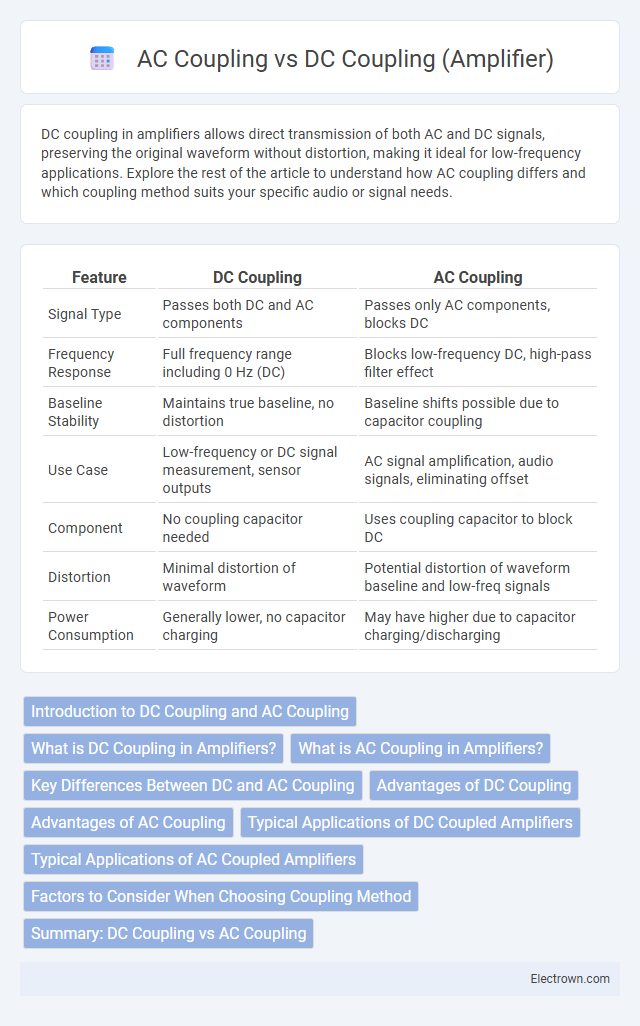DC coupling in amplifiers allows direct transmission of both AC and DC signals, preserving the original waveform without distortion, making it ideal for low-frequency applications. Explore the rest of the article to understand how AC coupling differs and which coupling method suits your specific audio or signal needs.
Table of Comparison
| Feature | DC Coupling | AC Coupling |
|---|---|---|
| Signal Type | Passes both DC and AC components | Passes only AC components, blocks DC |
| Frequency Response | Full frequency range including 0 Hz (DC) | Blocks low-frequency DC, high-pass filter effect |
| Baseline Stability | Maintains true baseline, no distortion | Baseline shifts possible due to capacitor coupling |
| Use Case | Low-frequency or DC signal measurement, sensor outputs | AC signal amplification, audio signals, eliminating offset |
| Component | No coupling capacitor needed | Uses coupling capacitor to block DC |
| Distortion | Minimal distortion of waveform | Potential distortion of waveform baseline and low-freq signals |
| Power Consumption | Generally lower, no capacitor charging | May have higher due to capacitor charging/discharging |
Introduction to DC Coupling and AC Coupling
DC coupling in amplifiers allows both AC and DC signals to pass directly between stages, preserving low-frequency and steady-state signals critical for applications requiring accurate DC level transmission. AC coupling introduces a capacitor between amplifier stages, blocking DC components and allowing only AC signals to pass, which is essential for removing DC offset and protecting subsequent circuits from potential DC damage. Understanding the choice between DC and AC coupling impacts signal integrity, frequency response, and overall amplifier performance in applications such as audio processing and instrumentation.
What is DC Coupling in Amplifiers?
DC coupling in amplifiers refers to a direct electrical connection between stages that allows both AC and DC signals to pass through without any blocking components like capacitors or transformers. This method preserves the full signal waveform, including the DC offset, making it essential for applications requiring accurate low-frequency or steady-state signal amplification. Your choice of DC coupling ensures minimal phase distortion and ideal performance in precision measurement or sensor circuits where maintaining the DC level is critical.
What is AC Coupling in Amplifiers?
AC coupling in amplifiers involves using a capacitor or transformer to block direct current (DC) components while allowing alternating current (AC) signals to pass. This technique prevents shifts in the amplifier's operating point caused by DC offsets, maintaining signal integrity for AC signals. Your choice between AC coupling and DC coupling depends on whether you need to amplify signals with or without DC components.
Key Differences Between DC and AC Coupling
DC coupling transmits both AC and DC signals, maintaining the original signal's baseline and allowing low-frequency and steady-state components to pass through an amplifier. AC coupling uses a capacitor to block DC components, passing only AC signals and effectively eliminating offset voltages or drift from the output. The choice between DC and AC coupling depends on the application's need to preserve the signal's DC level or to reject DC offsets and noise.
Advantages of DC Coupling
DC coupling in amplifiers enables direct transmission of low-frequency and DC signals without distortion or phase shift, ensuring accurate signal integrity. Your audio or measurement systems benefit from improved linearity and reduced signal loss, especially for applications requiring precise low-frequency response. This coupling type also simplifies the circuit design by eliminating the need for large coupling capacitors that can introduce noise and drift.
Advantages of AC Coupling
AC coupling in amplifiers effectively blocks DC offset voltages, preventing distortion and saturation, which enhances signal integrity for AC signals. It allows for the transmission of varying signal levels without shifting the baseline, making your audio or communication system more stable and reliable. This method is particularly advantageous in applications requiring isolation from DC components while maintaining high-frequency response.
Typical Applications of DC Coupled Amplifiers
DC coupled amplifiers are commonly used in precision measurement systems, sensor signal processing, and low-frequency analog circuits where accurate voltage reproduction from DC to low frequencies is critical. They are ideal for applications such as biomedical instrumentation, strain gauge amplification, and audio signal processing that require minimal phase distortion and stable DC response. Typical uses include operational amplifiers in data acquisition, instrumentation amplifiers in sensor interfaces, and servo control loops in industrial automation.
Typical Applications of AC Coupled Amplifiers
AC coupled amplifiers are commonly used in audio equipment, communication systems, and signal processing applications where eliminating DC offset is crucial for accurate signal reproduction. Their ability to block low-frequency noise and prevent amplifier saturation makes them ideal for amplifying audio signals and high-frequency communication signals. This coupling method is preferred in scenarios involving variable DC baselines or when isolating input and output stages in mixed-signal circuits.
Factors to Consider When Choosing Coupling Method
When selecting between DC coupling and AC coupling in amplifiers, consider signal frequency, offset voltage, and signal integrity requirements. DC coupling preserves low-frequency signals and DC components but may introduce offset errors, while AC coupling blocks DC offsets but can distort low-frequency response. Your choice impacts amplifier performance, especially in applications requiring precise DC measurements or clean signal transmission.
Summary: DC Coupling vs AC Coupling
DC coupling in amplifiers maintains the direct current component of the input signal, allowing both AC and DC signals to pass through without distortion, which is essential for measuring low-frequency or static signals accurately. AC coupling uses a capacitor to block the DC component, isolating the amplifier from any DC offset and preventing drift, making it ideal for amplifying only the varying part of the signal. Your choice between DC and AC coupling depends on whether you need to preserve DC information or focus solely on the AC variations in the signal.
DC Coupling vs AC Coupling (Amplifier) Infographic

 electrown.com
electrown.com